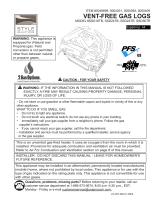
www.desatech.com
120163-01A4
1. This appliance, as supplied, is only for use
with the type of gas indicated on the rating
plate. This appliance is not convertible for
use with other gases.
2. Do not place propane/LP supply tank(s) in-
side the structure. Locate propane/LP supply
tank(s) outdoors (propane/LP units only).
3. If you smell gas
• shut off gas supply
• do not try to light any appliance
• do not touch any electrical switch; do not use
any phone in your building
• immediately call your gas supplier from a
neighbor’s phone. Follow the gas supplier’s
instructions
• if you cannot reach your gas supplier, call
the re department
4. This heater shall not be installed in a bedroom
or bathroom, unless installed as a vented appli-
ance. See Installing Damper Clamp Accessory
for Vented Operation, page 12. This gas log set
may not be installed as a vented appliance in a
bedroom or bathroom in the Commonwealth
of Massachusetts.
5. Before installing in a solid fuel burning replace,
the chimney ue and rebox must be cleaned of
soot, creosote, ashes and loose paint by a qualied
chimney cleaner. Creosote will ignite if highly
heated. Inspect chimney ue for damage. If dam-
aged, repair ue before operating appliance.
6. If replace has glass doors, never operate with
glass doors closed, If you operate heater with
doors closed, heat buildup inside replace will
cause glass to burst. Also if replace opening
has vents at the bottom, you must open the
vents before operating heater.
7. To prevent the creation of soot, follow the instruc-
tions in Cleaning and Maintenance, page 20.
8. Before using furniture polish, wax, carpet
cleaner or similar products, turn heater off. If
heated, the vapors from these products may
create a white powder residue within the burner
box or on adjacent walls and furniture.
9. This heater needs fresh, outside air ventilation
to run properly this heater has an Oxygen De-
pletion Sensing (ODS) safety shutoff system.
The ODS shuts down the heater if enough fresh
air is not available. See Air Combustion and
Ventilation page 6. If the heater keeps shutting
off, see Troubleshooting, page 22.
SAFETy INFORMATION
Continued
10. Do not run heater where ammable liquids or
vapors are used or stored, or un d er du s t y
conditions.
11. Do not use heater to cook food or burn paper
or other objects.
12. Do not use heater if any part has been exposed
to or under water. Immediately call a qualied
service technician to inspect the room heater
and to replace any part of the control system and
any gas control which has been under water.
13. Do not operate heater if any log is broken. Do
not operate heater if a log is chipped (dime-
size or larger).
14. Turn heater off and let cool before servicing,
installing or repairing. Make sure the selector
switch is in the OFF position. Only a quali-
ed service person should install, service or
repair heater.
15. Make sure the selector switch is in the OFF
position when you are away from home for
long periods of time.
16. Remote-ready heaters shall not be connected
to any external electrical source.
17. Operating heater above elevations of 4,500
feet may cause pilot outage.
18. To prevent performance problems, do not use
propane/LP tank(s) of less than 100 lb. capac-
ity (propane/LP units only).
19. Provide adequate clearances around air
openings.
PRODUCT
IDENTIFICATION
-
Figure 1 - Product Identication
Log Set
Chassis
Assembly
























